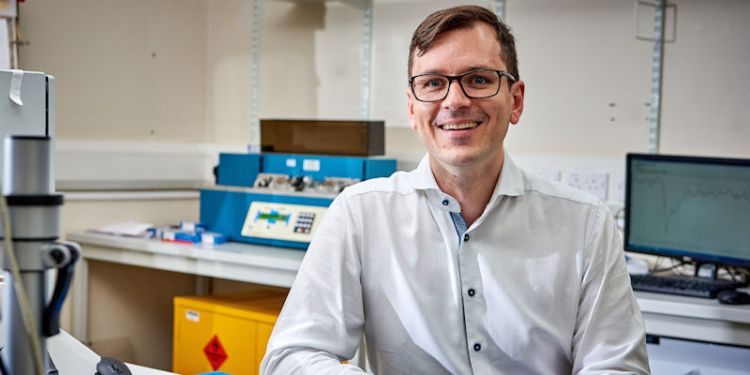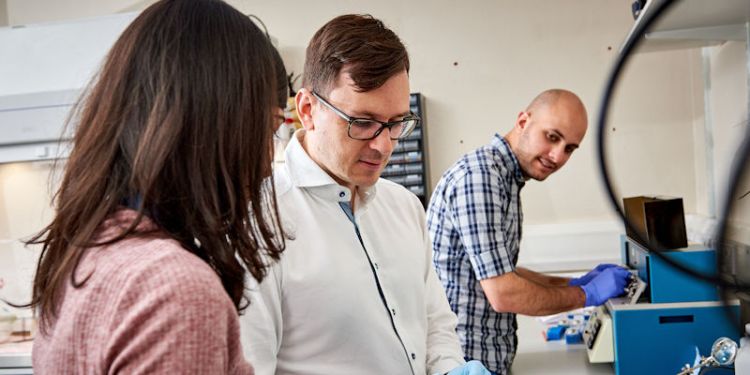Nano-needles provide insight into cancer cell growth

Nano surgery using needles the width of a molecule of DNA, could help surgeons and cell biologists unravel the mystery of why some cancer cells resist chemotherapy and how some neurodegenerative diseases develop.
Dr Paolo Actis, a University Academic Fellow in the School of Electronic and Electrical Engineering, is working with cell biologists and oncologists from the University of Leeds School of Medicine and Health, to enable accurate surgery on a cellular level. The glass needles he has developed are 1000x smaller than the width of a human hair and can be used to take biopsies of material within a single cell. Crucially this can be done while keeping the cell alive, which opens up the possibility of tracking what happens within cells during cancer treatment, which has not been possible before.
The glass needles he has developed are 1000x smaller than the width of a human hair and can be used to take biopsies of material within a single cell. Crucially this can be done while keeping the cell alive...
Surgeons have found that a small number of cancer cells (typically 0.1%) can develop a resistance to chemotherapy and will later go on to spread cancer around the body. It has been difficult to investigate this issue because the problems occur in individual cells during cancer treatment.
Live cell sampling
With the new needle technology and the electronically controlled biopsy procedures developed by Paolo, surgeons can go inside cells and take accurate samples of different cell contents like RNA, for example. It would be possible for samples to be taken from the live cells before, during and after chemotherapy to observe any changes that might lead to drug resistance.
“I am developing tools to help cancer researchers get to a whole new level of research and gain an understanding of cell mechanisms” says Paolo Actis. His work is funded by the Brain Tumour Charity.
The tiny needle acts like an electronic syringe, using the principles of electro-wetting, to suck in a tiny sample when inserted into the cell.
The needles are created using a laser to melt a glass capillary which is then stretched to create the ultra-fine needles. The tiny needle acts like an electronic syringe, using the principles of electro-wetting, to suck in a tiny sample when inserted into the cell. The technique developed by Dr Actis can very accurately control the voltage and time it is applied for, which determines how much sample is taken in.

The glass needles Dr Actis has developed are 1000x smaller than the width of a human hair and can be used to take biopsies of material within a single cell
Unravelling the complexities of cell biology
The new technology is versatile and can be used to study many of the most challenging questions in cell biology. Dr Actis is using the technology in a project collaboration with Newcastle University which is investigating mitochondria, the energy source of cells. Problems with the mitochondria are linked to the development of neurodegenerative diseases such as Parkinson’s and muscular dystrophy. Here, the needles can be used to insert proteins or other agents in to the cells to explore the resulting interaction with the cell. This could eventually lead to better understanding of these illnesses and the potential for new drug treatments.
The new technology... could eventually lead to better understanding of these illnesses and the potential for new drug treatments.
Paolo is also working with virologists from the University of Leeds to further the scientific understanding of viruses. The tiny needles can be used to inject small amounts of viral DNA/RNA very precisely into individual live cells to simulate infection in the body. The researchers can observe the infection pathway into neighbouring cells and any changes that occur in the viral material. This approach is a more accurate simulation of what actually happens in the body, than techniques currently available to virologists, which involve infecting many cells at once.
Diverse applications
Paolo coordinates a European network of researchers using nano-needle technology for applications as diverse as medical research and materials research. “The technology can be used with few changes to study energy materials for batteries for electric cars and companies are interested in these applications” explains Paolo, who began his career in materials science. “However I feel most excited by the cell research, as this is the most unique thing”

Paolo coordinates a European network of researchers using nano-needle technology for applications as diverse as medical research and materials research
Paolo’s research is supported by the European Commission, The Brain Tumour Charity, EPSRC, MRC and the University of Leeds.
Contact us
If you would like to discuss this area of research in more detail, please contact Dr Paolo Actis.

